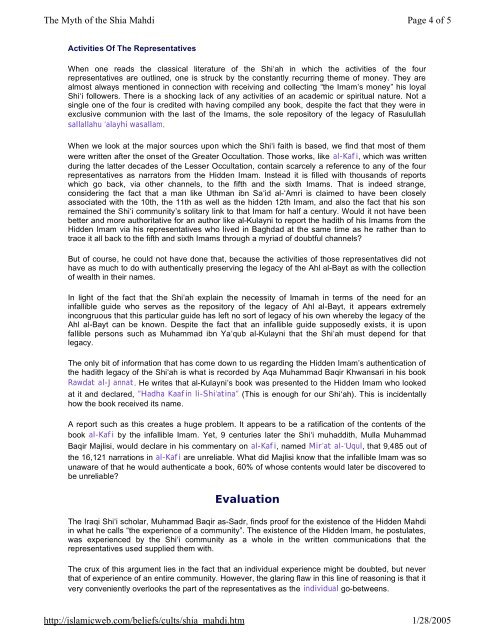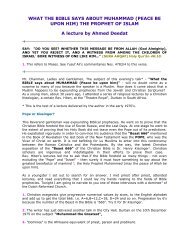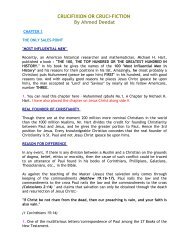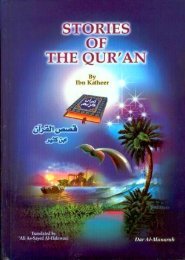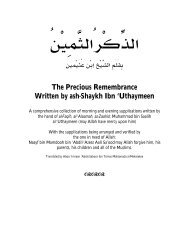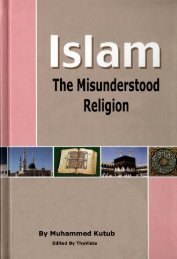Collection Of Articles (Refuting Shia) - Enjoy Islam
Collection Of Articles (Refuting Shia) - Enjoy Islam
Collection Of Articles (Refuting Shia) - Enjoy Islam
Create successful ePaper yourself
Turn your PDF publications into a flip-book with our unique Google optimized e-Paper software.
The Myth of the <strong>Shia</strong> Mahdi<br />
Page 4 of 5<br />
Activities <strong>Of</strong> The Representatives<br />
When one reads the classical literature of the Shi‘ah in which the activities of the four<br />
representatives are outlined, one is struck by the constantly recurring theme of money. They are<br />
almost always mentioned in connection with receiving and collecting “the Imam’s money” his loyal<br />
Shi‘i followers. There is a shocking lack of any activities of an academic or spiritual nature. Not a<br />
single one of the four is credited with having compiled any book, despite the fact that they were in<br />
exclusive communion with the last of the Imams, the sole repository of the legacy of Rasulullah<br />
sallallahu ‘alayhi wasallam.<br />
When we look at the major sources upon which the Shi‘i faith is based, we find that most of them<br />
were written after the onset of the Greater Occultation. Those works, like al-Kafi, which was written<br />
during the latter decades of the Lesser Occultation, contain scarcely a reference to any of the four<br />
representatives as narrators from the Hidden Imam. Instead it is filled with thousands of reports<br />
which go back, via other channels, to the fifth and the sixth Imams. That is indeed strange,<br />
considering the fact that a man like Uthman ibn Sa‘id al-‘Amri is claimed to have been closely<br />
associated with the 10th, the 11th as well as the hidden 12th Imam, and also the fact that his son<br />
remained the Shi‘i community’s solitary link to that Imam for half a century. Would it not have been<br />
better and more authoritative for an author like al-Kulayni to report the hadith of his Imams from the<br />
Hidden Imam via his representatives who lived in Baghdad at the same time as he rather than to<br />
trace it all back to the fifth and sixth Imams through a myriad of doubtful channels<br />
But of course, he could not have done that, because the activities of those representatives did not<br />
have as much to do with authentically preserving the legacy of the Ahl al-Bayt as with the collection<br />
of wealth in their names.<br />
In light of the fact that the Shi‘ah explain the necessity of Imamah in terms of the need for an<br />
infallible guide who serves as the repository of the legacy of Ahl al-Bayt, it appears extremely<br />
incongruous that this particular guide has left no sort of legacy of his own whereby the legacy of the<br />
Ahl al-Bayt can be known. Despite the fact that an infallible guide supposedly exists, it is upon<br />
fallible persons such as Muhammad ibn Ya‘qub al-Kulayni that the Shi‘ah must depend for that<br />
legacy.<br />
The only bit of information that has come down to us regarding the Hidden Imam’s authentication of<br />
the hadith legacy of the Shi‘ah is what is recorded by Aqa Muhammad Baqir Khwansari in his book<br />
Rawdat al-Jannat. He writes that al-Kulayni’s book was presented to the Hidden Imam who looked<br />
at it and declared, “Hadha Kaafin li-Shi‘atina” (This is enough for our Shi‘ah). This is incidentally<br />
how the book received its name.<br />
A report such as this creates a huge problem. It appears to be a ratification of the contents of the<br />
book al-Kafi by the infallible Imam. Yet, 9 centuries later the Shi‘i muhaddith, Mulla Muhammad<br />
Baqir Majlisi, would declare in his commentary on al-Kafi, named Mir’at al-‘Uqul, that 9,485 out of<br />
the 16,121 narrations in al-Kafi are unreliable. What did Majlisi know that the infallible Imam was so<br />
unaware of that he would authenticate a book, 60% of whose contents would later be discovered to<br />
be unreliable<br />
Evaluation<br />
The Iraqi Shi‘i scholar, Muhammad Baqir as-Sadr, finds proof for the existence of the Hidden Mahdi<br />
in what he calls “the experience of a community”. The existence of the Hidden Imam, he postulates,<br />
was experienced by the Shi‘i community as a whole in the written communications that the<br />
representatives used supplied them with.<br />
The crux of this argument lies in the fact that an individual experience might be doubted, but never<br />
that of experience of an entire community. However, the glaring flaw in this line of reasoning is that it<br />
very conveniently overlooks the part of the representatives as the individual go-betweens.<br />
http://islamicweb.com/beliefs/cults/shia_mahdi.htm<br />
1/28/2005


